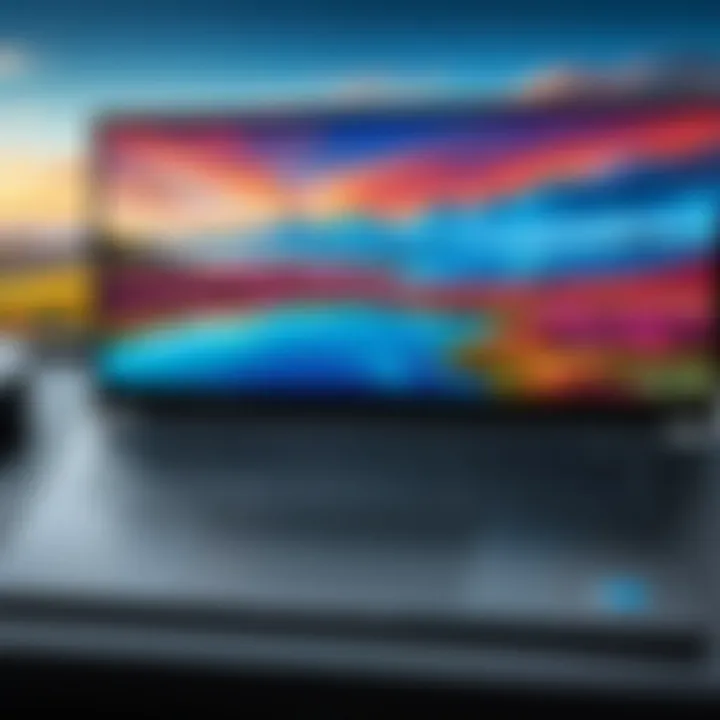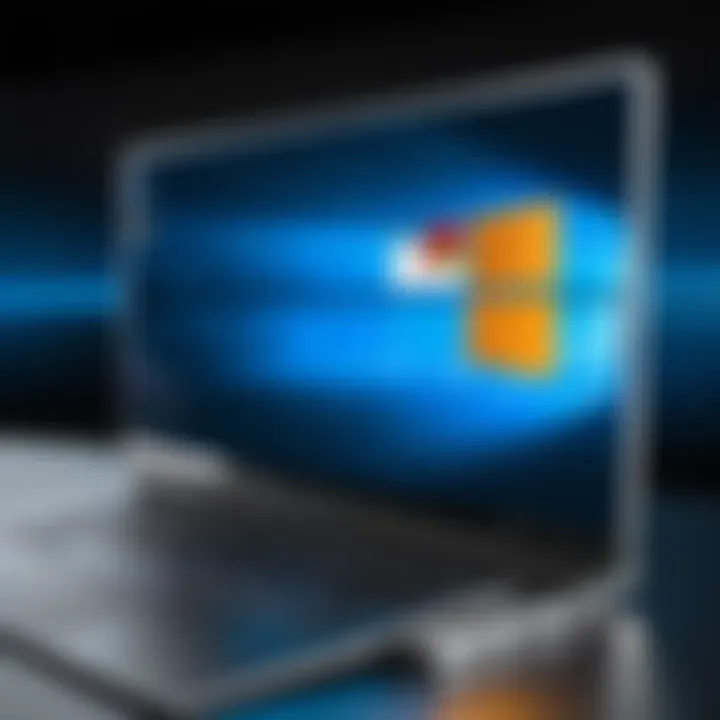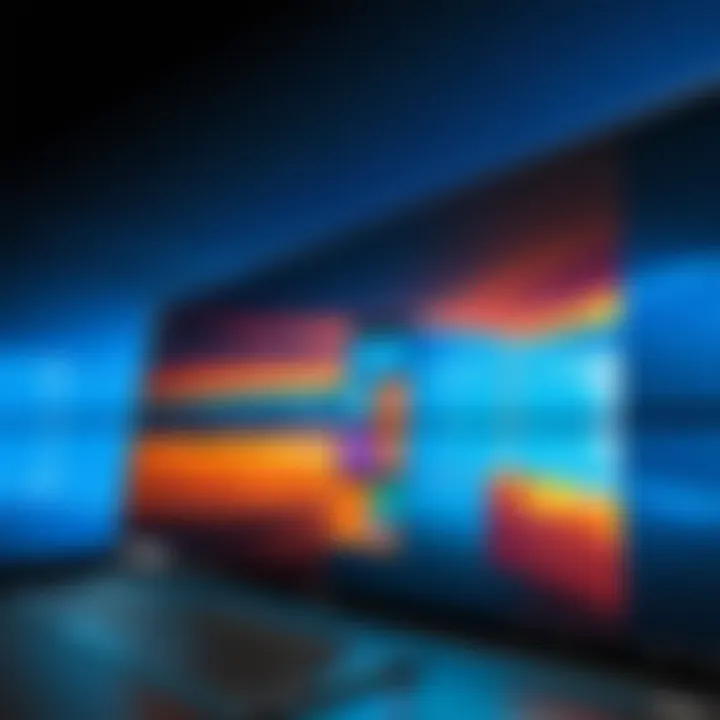Understanding Windows 10 Desktop Background: A Comprehensive Guide


Intro
The Windows 10 desktop background may seem like a simple feature, but it has implications that extend beyond mere aesthetics. It serves as a canvas for creativity and functionality, allowing users to personalize their digital workspace. Understanding the desktop background is crucial for optimizing the user experience and impacting productivity. This guide delves into various aspects of the Windows 10 desktop background, including customization options, performance considerations, and how these factors interact with user engagement.
In the forthcoming sections, we will comprehensively explore key features, performance analyses, and practical tips to enhance your desktop environment. From selecting high-resolution images to understanding the importance of color schemes, this journey aims to equip tech-savvy users with knowledge that turns a basic desktop background into an optimized digital experience.
Product Overview
Windows 10 provides a range of options for customizing the desktop background, which can impact both the device performance and user experience.
Key Features
- Personalization: Users can opt for solid colors, photos, or even slideshow presentations as background options. Prospective choices include:
- Ease of Access: Windows 10 makes changing backgrounds straightforward. Users can navigate to Settings > Personalization > Background to quickly adjust their desktops.
- Dynamic Options: The operating system allows for dynamic backgrounds that can change based on the time of the day or user preferences.
- Customized wallpapers
- Thematic colors
- Animated backgrounds
Specifications
To achieve optimal results, it is advisable for users to consider the following specifications when selecting a desktop background:
- Resolution: It is crucial to choose images that match or exceed the screen’s native resolution to avoid pixelation.
- File Formats: Preferred formats include JPG, PNG, and BMP for better quality and compatibility.
- Aspect Ratio: Matching the aspect ratio of the desktop screen helps prevent image distortion.
Performance Analysis
Incorporating a desktop background into Windows 10 requires consideration of performance ramifications, particularly regarding speed and efficiency as well as battery life.
Speed and Efficiency
Using high-resolution images can affect system performance, particularly on devices with limited resources. Choosing optimized images can enhance speed. Considerations include:
- Image Size: Large images may slow down system performance. Opt for images that balance quality with size.
- Dynamic Backgrounds: While appealing, animated backgrounds can consume processing power. Users should assess whether the visual appeal outweighs potential performance hits.
Battery Life
For laptops and portable devices, the desktop background choice can impact battery consumption.
- Dark Themes: Using darker images may reduce battery usage as light backgrounds typically require more power from the display.
- Static vs. Dynamic: Static images generally consume less power compared to animated backgrounds, making them preferable for extending battery life.
Investing time in customizing your desktop background not only enhances visual appeal but can also foster an efficient work environment, contributed to an optimized user experience.
Preamble to Windows Desktop Background
The desktop background in Windows 10 serves as more than just a visual backdrop; it represents a crucial aspect of user interaction with the operating system. When one powers up a device, the first thing often noticed is the desktop environment, establishing an immediate connection between the user and their digital workspace.
In this article, we will discuss the significance of desktop backgrounds, reflecting on their many functions such as personalization, aesthetic appeal, and even psychological impact. Understanding these elements is key to optimizing one’s experience on Windows 10.
Key Elements of Desktop Backgrounds
- Visual Identity: The choice of wallpaper offers a reflection of one's personality or mood.
- Functional Utility: Backgrounds can enhance focus or serve as reminders through images that motivate.
- Cohesive Environment: An aesthetically pleasing desktop may contribute to a more organized and inviting workspace.
Benefits to Consider
Customizing a desktop background can lead to increased satisfaction and productivity. A user may find that a familiar or favorite image can evoke positive emotions, reducing stress while aiding concentration. Furthermore, a personalized background aligns the device with its owner, creating a sense of ownership and pride.
Ultimately, the Windows 10 desktop background is not merely a decorative element; it shapes user experience significantly. Making informed choices can lead to enhanced visual appeal and functionality, contributing positively to one’s overall interaction with technology.
The Significance of Desktop Backgrounds
Desktop backgrounds play an often-overlooked role in shaping user interactions and overall computer experience. As the first visual element seen when logging into a device, they set the tone for the user's environment. A thoughtfully chosen background can inspire creativity, promote productivity, and even enhance mental well-being. By understanding the significance of desktop backgrounds, users can judiciously select images that resonate with their personal preferences and optimize their workflow.
Impact on User Experience
The user experience is greatly influenced by the desktop background. A visually appealing image can make the workspace feel more inviting. This simple change can uplift one’s mood and facilitate a more pleasant technological interaction. Moreover, a desktop that reflects an individual’s tastes can foster a sense of belonging and personal ownership of the device. In a world where people spend considerable time on computers, having a background that resonates with them can lead to greater satisfaction and engagement.
For example, a study by Human-Computer Interaction experts indicates that aesthetic design elements can significantly affect user satisfaction. An effective desktop background might reduce eye strain or create a calming visual atmosphere, leading to a productive mindset when completing tasks. Attention to these details can aid in minimizing distractions and increasing efficiency.
Psychological Effects of Colors
Colors have profound psychological implications and can impact emotions and behaviors. A desktop background predominantly featuring warm colors like reds and oranges may evoke feelings of energy and excitement. In contrast, cooler hues such as blue and green can inspire tranquility and focus. It is crucial for users to be mindful of color choices in desktop backgrounds as these choices can affect not only mood but also productivity.


Research in the field of color psychology suggests that distinct colors can drive different emotions and even cognitive performance. For instance, using a soft blue background could enhance concentration during intensive tasks, while a bright yellow might stimulate creativity during brainstorming sessions.
"The colors you surround yourself with can influence your mood, creativity, and overall outlook."
Ultimately, being aware of how color can affect one’s desktop environment allows for more intentional selections. Through the right combination of visuals and colors, users can create a desktop background that supports their workflow and caters to their emotional needs.
Types of Desktop Backgrounds
The desktop background serves not only as a visual element but also plays a critical role in user personalization and productivity. Understanding the various types of desktop backgrounds helps users make informed decisions when choosing the aesthetic that best fits their needs. There are three main categories of desktop backgrounds: static backgrounds, dynamic or slideshow backgrounds, and live wallpapers. Each type brings its own set of advantages and considerations, catering to different preferences.
Static Backgrounds
Static backgrounds are the most common choice among Windows 10 users. They involve a single image permanently set as the wallpaper. This simplicity can enhance focus and reduce the distraction that can arise from constantly changing visuals. Users can select their favorite photographs, minimalist designs, or professional graphics to project their style or mood.
A key benefit of static backgrounds is that they consume minimal system resources. This makes them ideal for devices with lower processing power or for situations where battery life is a concern. Static images typically have straightforward color schemes, which can create a calming environment. However, the downside is the lack of variety. Users may grow tired of seeing the same image day after day, which can decrease excitement in their computing experience.
Dynamic or Slideshow Backgrounds
Dynamic backgrounds offer a fresh experience by enabling a slideshow of multiple images. Users can select a folder containing several images, and Windows 10 will automatically cycle through them at a specified interval. This option appeals to those who enjoy variety in their desktop environment without needing to manually change wallpapers constantly.
Dynamic backgrounds maintain user interest and engagement. They are particularly useful for users who want to showcase a collection of personal photographs or artwork. However, there are some considerations to keep in mind. Depending on the frequency of change, dynamic backgrounds might consume slightly more system resources than static ones, which can impact performance in low-resource devices. Additionally, rapid changes can be visually overwhelming for some individuals.
Live Wallpapers
Live wallpapers add a layer of interactivity and motion to the desktop experience. These backgrounds can include animations or real-time graphics that respond to user actions, creating a dynamic visual experience. Live wallpapers can enhance creativity and add a personal touch to one’s desktop.
However, live wallpapers generally require more computational resources. Users should consider the trade-off between aesthetic appeal and performance impact. Those using multiple applications or games may find that live wallpapers affect system performance negatively. Thus, individuals should evaluate their device capabilities before opting for this type of background.
Customization Options in Windows
Customization is a significant aspect of using Windows 10. It empowers users to personalize their environment according to their preferences. This personalization contributes to user satisfaction and can enhance productivity. When it comes to desktop backgrounds, Windows 10 offers multiple options that cater to different needs. From setting up your desktop background to choosing the right image and adjusting settings, each element plays a role in creating a visually appealing workspace.
Setting Up the Desktop Background
Setting up the desktop background is the first step in the customization process. Users can easily change their wallpaper by right-clicking on the desktop and selecting "Personalize." This option leads to the "Background" settings, where users can choose their desired image type. The straightforward process allows for a quick transition from the default setup to a more personalized aesthetic, accommodating individual tastes and preferences.
Choosing the Right Image
The choice of image for the desktop background is crucial. Options include personal photos, artistic images, or even organizational logos. High-quality images are recommended, as this can impact the overall look of the desktop. Paying attention to the theme of the chosen image is important. For instance, calming landscapes may enhance focus, while vibrant artwork might energize the workspace. Users should consider their work habits and select images that resonate or inspire them in their daily tasks.
Adjusting Background Settings
Once an image is selected, the next step involves adjusting background settings. There are four main settings users can manipulate: Fit, Fill, Stretch, and Center. Each setting significantly influences how the image appears on the screen, thus affecting the user's visual experience.
Fit
The "Fit" option adjusts the selected image to match the screen's dimensions while maintaining its original aspect ratio. The key characteristic of "Fit" is that it displays the entire image without distortion. This is a beneficial choice, especially for images that contain intricate details. The unique feature of this setting lies in its ability to preserve the integrity of the image. However, this may result in blank space on the edges if the image does not have the same aspect ratio as the screen.
Fill
The "Fill" option fills the entire screen with the chosen image. This setting stretches the image to cover the display, making it a popular choice for wallpapers that are meant to provide an immersive experience. The advantage of using "Fill" is the absence of blank space, contributing to a more cohesive visual aesthetic. However, the downside is that it can distort the image, particularly if the original proportions differ from the display’s.
Stretch
"Stretch" is another setting that alters the image to fill the entire screen, irrespective of the aspect ratio. It is a flexible option that allows users to cover the screen entirely. The main characteristic of "Stretch" is its adaptability, making it suitable for various image types. Despite being a versatile choice, this setting has the drawback of distorting images more evidently, which could detract from the original content of the wallpaper.
Center
The "Center" option displays the image in its original size, placing it in the center of the desktop. This is especially effective for smaller images that need emphasis. The key characteristic of this setting is simplicity; it avoids any distortion or stretching. This method allows users to focus on specific parts of an image, which can be especially advantageous when using logos or small artworks. However, it may leave a significant amount of blank space around larger displays, which might not be visually appealing for all users.
Choosing the right background settings can profoundly influence your overall experience with Windows 10. It is essential to experiment with these settings to find what works best for you.
In summary, customization options in Windows 10 offer a range of tools that allow for personal expression and functionality. By carefully considering how to set up the desktop background, choosing the right image, and adjusting background settings, users can create a desktop experience that meets their unique needs.
Performance Considerations
Performance considerations are crucial when selecting and managing desktop backgrounds in Windows 10. The choice of backgrounds may seem aesthetic, but it directly impacts system resources and overall efficiency. This section delves into the nuances of resource management and battery life, emphasizing the importance of awareness in these areas.
Resource Management Implications


Resource management is a vital aspect to consider when setting up desktop backgrounds. Backgrounds do not exist in isolation; they use system resources. Every image or wallpaper contributes to the demand placed on the CPU and GPU. High-resolution images can consume significant amounts of memory and processing power. This consumption may slow down other applications and detract from the system performance.
- High-resolution Images: Using 4K or high-definition images can enhance visual appeal but may cause sluggishness in older hardware due to higher resource demands.
- Dynamic Backgrounds: Animated backgrounds, while visually engaging, tend to consume more resources than static images. They can result in noticeable delays when switching between tasks.
- Monitoring Performance: Users should utilize the built-in Task Manager to monitor how much CPU or GPU resources are being used by the desktop background.
Regularly managing and selecting less resource-intensive backgrounds can lead to a smoother operating experience without sacrificing usability.
By choosing appropriate backgrounds, users can ensure that the system remains responsive and easy to work with, leading to better overall productivity.
Effects on Battery Life
The choice of desktop background can also significantly influence battery life, particularly on laptops and portable devices. Understanding how backgrounds affect power consumption is critical for users who rely on mobility.
- Static vs. Dynamic Backgrounds: Static backgrounds have minimal impact on battery life. In contrast, dynamic and animated backgrounds demand constant processing power, which drains the battery faster.
- Brightness and Color: Bright and colorful images can keep screen brightness high, increasing the load on the GPU, thereby consuming more battery. Darker images may help in extending battery life, especially on OLED screens where black pixels do not consume power.
- Performance Settings: Windows 10 provides options within power settings that optimize performance or extend battery life. Adjusting these settings can help in managing the overall impact of desktop backgrounds on battery endurance.
Understanding these considerations allows users to make informed decisions that mentally balance aesthetics with practicality. By selecting the right background and adjusting image properties, users can preserve both battery life and enhance system performance.
Accessibility Features for Backgrounds
The accessibility features of Windows 10 desktop backgrounds play a crucial role in ensuring that all users can enjoy a comfortable and functional computing environment. For individuals with visual impairments or specific preferences, effective use of background options is essential. This section delves into two primary accessibility measures: high contrast options and custom themes designed specifically for improved visibility.
High Contrast Options
High contrast options are a fundamental aspect of accessibility in Windows 10. They are designed to assist users who may have difficulty distinguishing between different colors and shades. By activating high contrast settings, users can dramatically change the visual appearance of their desktop background and other UI elements. This helps improve visibility and reduces strain on the eyes.
Benefits of high contrast backgrounds include:
- Enhanced visibility of text and icons against the background.
- Reduced eye fatigue, which is especially beneficial for prolonged computer use.
- Greater focus on tasks by minimizing distractions from background imagery.
To enable high contrast options, users can follow these steps:
- Open the Settings application.
- Navigate to Ease of Access.
- Select High Contrast from the menu.
- Turn on the toggle for high contrast settings.
- Choose a theme from the dropdown menu.
By implementing high contrast backgrounds, Windows 10 better caters to a diverse user base, allowing each individual to enjoy a personalized and efficient computing space.
Custom Themes for Visibility
Custom themes for visibility further enhance the accessibility of Windows 10 desktop. This feature allows users to tailor their visual experience according to their specific requirements. By customizing themes, individuals can choose colors and elements that suit their needs better. This is particularly beneficial for those with specific color blindness or sensitivity to certain hues.
Custom themes can include:
- Color adjustments for text and backgrounds to ensure optimal visibility.
- Custom wallpapers that have been specifically designed with accessibility in mind, focusing on clear, simple images.
- Interface customization that aligns contrast levels and colors across the system to provide a cohesive experience.
To create or modify a custom theme, users can:
- Access the Settings menu.
- Go to Personalization.
- Choose Themes and click Customize.
- Select the elements they want to alter, including colors, sounds, and backgrounds.
Implementing these accessibility features is not just about personal preference; it is about creating an inclusive digital environment. Enhancing visibility through high contrast options and custom themes ensures that all users can navigate their desktops effectively.
Utilizing accessibility features not only improves functionality but also fosters an inclusive and user-friendly environment for all software users.
Selecting the Right Resolution
Choosing the right resolution for your desktop background is a crucial aspect of personalizing your Windows 10 experience. This decision can significantly influence how the images appear, affecting their clarity and overall aesthetic appeal. It also ties directly into the performance of your system. A resolution that aligns with the capabilities of your display can prevent distortion, blurriness, or pixelation.
Understanding the relationship between the resolution of your image and the native resolution of your monitor is essential. A higher resolution image will typically deliver better quality on high-definition displays, ensuring that every detail is sharp and vibrant. Conversely, using a low-resolution image could result in visual artifacts that detract from the user experience.
When selecting an appropriate resolution, consider the following aspects:
- Monitor Specifications: Check the native resolution of your device. Common resolutions include 1920x1080 for Full HD and 3840x2160 for 4K displays.
- Aspect Ratio: Make sure the aspect ratio of the background matches that of your monitor to avoid stretching or cropping.
- Usage Context: Think about how often you'll see the background. For a workspace, a cleaner, minimalistic image might be sufficient. If you frequently use your device for entertainment, opt for rich visuals.
Ultimately, selecting the right resolution enhances not only the look of your desktop but also contributes to an overall enjoyable computing experience.
Understanding Display Resolutions
Display resolution refers to the amount of pixel data needed to form an image on the screen. It is usually denoted by the number of pixels in each dimension, such as width x height. Higher resolutions mean more pixels, which leads to sharper images and greater detail. For instance, 4K resolution (3840x2160) offers four times the pixel count of 1080p (1920x1080). This difference is particularly noticeable on larger screens or when viewing detailed images such as photographs or intricate designs.
It is also important to understand that not all images are created equal. An image designed for a specific resolution will perform best when displayed at that resolution. If scaled improperly, the image can suffer in quality. As such, it is advisable to choose a background that matches or exceeds your monitor’s native resolution.
Implications of Image Quality


The quality of the image used as a desktop background has various implications. High-quality images tend to have better colors, details, and overall textures. These qualities can enhance the user’s emotional and psychological connection with the workspace. A pleasing background can reduce fatigue and increase productivity.
Low-quality images might not only look unappealing, but they can also distract users and undermine the professionalism of a workspace. Some common issues associated with poor-quality images include:
- Pixelation: This occurs when a low-resolution image is enlarged beyond its capability.
- Color Fading: Images might lose vibrance on certain platforms if not saved properly.
- Inconsistent Lighting: Improperly lit images can make the background feel uneven or even unsettling.
"A well-chosen desktop background is a silent yet steadfast partner in your daily computing experiences."
For more information on display resolutions, visit Wikipedia.
For an in-depth article about image quality, check Britannica.
You can also share your thoughts on these topics in community discussions on Reddit.
Exploring Third-Party Solutions
In the realm of Windows 10 desktop backgrounds, third-party solutions offer unique options to augment the user experience. These alternatives often provide more flexibility compared to built-in features. Users can tailor their desktop aesthetic and functionality to reflect personal preferences or organizational needs. Exploring these tools helps uncover new ways to enhance productivity and enjoyment when interacting with the desktop.
Background Management Applications
Background management applications are pivotal for users seeking versatility and personalization in their desktop backgrounds. These applications come with several features that enhance user interaction. Examples include Wallpaper Engine and Fences. Users can manage multiple backgrounds with ease. It allows the implementation of dynamic wallpapers or organizing icons in a visually appealing manner.
Benefits of using management applications include:
- User Control: Users can select from an extensive library of images or upload their own.
- Customization Options: Many applications let users create playlists of wallpapers, changing them at specified intervals seamlessly.
- Resource Management: Provided tools can optimize background settings to maintain system performance.
Before selecting an application, it is wise to check system requirements and user reviews to ensure performance alignment with individual devices.
Online Repositories for Backgrounds
Online repositories are another fantastic resource for users looking for stunning desktop backgrounds. Websites like Unsplash, Pexels, and Reddit communities focus on digital art. They offer high-quality images that users can download and apply with minimal effort. This resource is invaluable for those who desire a fresh look without the effort needed to create their own images.
Considerations when using online repositories include:
- Image Quality: Opt for high-resolution images to avoid pixelation or distortion.
- Licensing: Always check the usage rights for images. Some may require attribution or have restrictions on use.
- Community Recommendations: Forums such as Reddit can offer curated lists or user feedback, guiding choices effectively.
Utilizing third-party solutions can greatly expand the customization capabilities of Windows 10 desktop backgrounds, enabling users to optimize their experience.
Addressing Common Issues
Addressing common issues related to Windows 10 desktop backgrounds is crucial for maintaining an efficient and visually appealing user interface. Many users encounter problems that can disrupt their experience. Understanding these issues can lead to quick resolutions, enhancing productivity and overall satisfaction with the operating system. Problems such as backgrounds not changing or display problems with images can be frustrating. Knowing how to tackle these problems can help users maintain a personalized and functional desktop environment.
Background Not Changing
One frequent issue that users face is the background not changing as expected. This can be due to several reasons. First, it is important to check if the selected image is compatible or corrupted. If the image file is damaged or in an unsupported format, Windows may fail to display it correctly.
Another reason may be related to the personalization settings. Users should ensure that their settings allow for personalization. Sometimes, Windows settings may revert to default or simplified modes due to updates or errors. Checking for any restrictions, especially in shared or enterprise environments, is also beneficial.
Here are some steps to resolve the problem:
- Right-click on the desktop and select Personalize.
- Navigate to the Background section and ensure a suitable option is selected.
- If using a slideshow, verify that the folder containing images is accessible.
- Restart the computer to apply any changes made.
By following these steps, users can often restore the functionality of their desktop background. Persistent issues may suggest the need for more technical troubleshooting.
Display Problems with Images
Display problems with images can manifest in several ways, such as images appearing distorted or pixelated. These issues can stem from the resolution settings on the monitor or the chosen image resolution itself. A mismatch between the image's resolution and the display's native resolution can lead to poor visual quality.
To resolve such display issues, users should verify the following:
- The resolution of the image matches or exceeds the monitor's native resolution. High-quality images should be preferred to ensure clarity.
- Check if the Fit, Fill, Stretch, or Center options are correctly applied. Each setting will adjust how the image appears on the desktop.
- Consider using the Preview feature in the background settings to see how the image will look before fully applying it.
"High-quality images not only enhance aesthetics but also contribute to a more enjoyable user experience."
Taking these steps can significantly improve the visual representation of desktop backgrounds. Regularly updating both the operating system and graphic drivers can also prevent future display issues, ensuring a smooth experience.
By proactively addressing these common issues, users can maintain a well-functioning desktop environment that reflects personal taste and meets functional needs.
Culmination
In this article, we have examined a considerable range of aspects related to Windows 10 desktop backgrounds. Each section has highlighted important features, considerations, and customization options that allow for an enhanced user experience. The conclusion serves as a reinforcement of the key points discussed throughout the article.
First, desktop backgrounds are not merely aesthetic elements; they play a crucial role in user experience and productivity. The impact of colors and images on mood can influence how users feel during their work sessions, potentially enhancing their focus and creativity. By understanding the psychological aspects of desktop backgrounds, individuals can make more informed choices about what to display on their screens.
Next, we addressed the customization options available in Windows 10. Choosing the right image and adjusting background settings can significantly shape the user interface. We learned about the different types of backgrounds—from static to dynamic—and their implications for performance. Each type has its pros and cons that users must consider based on their preferences and hardware capabilities.
It is also vital to recognize the resource implications associated with desktop backgrounds. A high-resolution image or a dynamic slideshow may enhance visual appeal but could also demand more system resources, affecting overall performance, particularly on less powerful machines. Balancing aesthetic desires with performance is essential for users.
Moreover, we discussed accessibility features within Windows 10. These options ensure that users can tailor their desktop environments in ways that accommodate their needs. This inclusivity allows for a more comfortable and pleasant computing experience.
Finally, the article offered insight into troubleshooting common issues that may arise, such as problems with background changing or display errors. Being informed about these aspects can save users time and frustration, encouraging a smoother interaction with their desktops.



